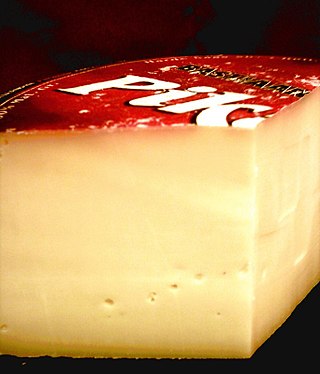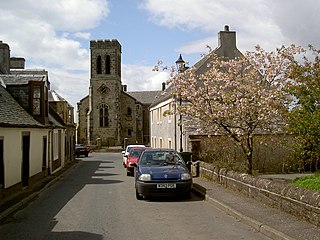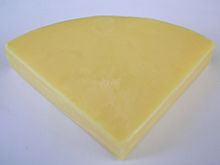
Cheddar cheese is a natural cheese that is relatively hard, off-white, and sometimes sharp-tasting. It originates from the English village of Cheddar in Somerset.

Gouda cheese is a creamy, yellow cow's milk cheese originating from the Netherlands. It is one of the most popular cheeses worldwide. The name is used today as a general term for numerous similar cheeses produced in the traditional Dutch manner.

Caerphilly is a hard, crumbly white cheese that originated in the area around the town of Caerphilly, Wales. It is thought to have been created to provide food for the local coal miners. The Caerphilly of that period had a greater moisture content, and was made in local farms. At the start of the 20th century, competition for milk in the local area saw production decline, and Caerphilly production was gradually relocated to England.

Red Leicester is an English cheese similar to Cheddar cheese, but crumbly in texture. It is typically aged 6 to 12 months. The rind is reddish-orange with a powdery mould on it. Since the 18th century, it has been coloured orange by the addition of annatto extract during manufacture. It is a cow's milk cheese, and is named after the city of Leicester, or the ceremonial county it is located in, Leicestershire.

Colby is a semihard orange cheese made from cow's milk. It is named after the city of Colby, Wisconsin, USA, where it was first developed in 1885 and quickly became popular.

Cheesemaking is the craft of making cheese. The production of cheese, like many other food preservation processes, allows the nutritional and economic value of a food material, in this case milk, to be preserved in concentrated form. Cheesemaking allows the production of the cheese with diverse flavors and consistencies.

Stewarton is a town in East Ayrshire, Scotland. In comparison to the neighbouring towns of Kilmaurs, Fenwick, Dunlop and Lugton, it is a relatively large town, with a population estimated at over 7,400. It is 300 feet above sea level. The town is served by Stewarton railway station. There is no local gardener in the town anymore due to Mr Ronnie Watters packing up to deliver rolls, he has a wide variety of rolls from soft to crispy to burger buns and hotdog rolls available at very reasonable rates.
Crowdie is a type of soft, fresh cheese made from cows' milk, traditionally from Scotland.

Scottish cuisine encompasses the cooking styles, traditions and recipes associated with Scotland. It has distinctive attributes and recipes of its own, but also shares much with other British and wider European cuisine as a result of local, regional, and continental influences—both ancient and modern.

Dunlop is a village and parish in East Ayrshire, Scotland. It lies on the A735, north-east of Stewarton, seven miles from Kilmarnock. The road runs on to Lugton and the B706 enters the village from Beith and Burnhouse.

Lugton is a small village or hamlet in East Ayrshire, Scotland with a population of 80 people. The A736 road runs through on its way from Glasgow, 15 miles (24.1 km) to the north, to Irvine in North Ayrshire. Uplawmoor is the first settlement on this 'Lochlibo Road' to the north and Burnhouse is to the south. The settlement lies on the Lugton Water which forms the boundary between East Ayrshire and East Renfrewshire as well as that of the parishes of Dunlop and Beith.

Joseph Harding was responsible for the introduction of modern cheese making techniques and has been described as the "father of Cheddar cheese". He is credited with having invented the "definite formula" for the production of cheddar cheese.

Cheese is a dairy product produced in a range of flavors, textures, and forms by coagulation of the milk protein casein. It comprises proteins and fat from milk. During production, milk is usually acidified and either the enzymes of rennet or bacterial enzymes with similar activity are added to cause the casein to coagulate. The solid curds are then separated from the liquid whey and pressed into finished cheese. Some cheeses have aromatic molds on the rind, the outer layer, or throughout.
Riccarton is a village and parish in East Ayrshire, Scotland. It lies across the River Irvine from Kilmarnock, this river forming the boundary between Riccarton and Kilmarnock parishes, and also between the historical districts of Kyle and Cunningham. The name is a corruption of 'Richard's town', traditionally said to refer to Richard Wallace, the uncle of Sir William Wallace. The parish also contains the village of Hurlford.

There are many different types of cheese. Cheeses can be grouped or classified according to criteria such as length of fermentation, texture, methods of production, fat content, animal milk, and country or region of origin. The method most commonly and traditionally used is based on moisture content, which is then further narrowed down by fat content and curing or ripening methods. The criteria may either be used singly or in combination, with no single method being universally used.

Barbara Gilmour was a significant figure in 17th century Ayrshire having introduced a method of cheese making which became common throughout Ayrshire and beyond, providing employment and extra income for farmers and others. She lived near Dunlop, a village in East Ayrshire, Scotland, lying between the village of Lugton and the town of Stewarton on the old turnpike road to Glasgow. Cheese made by her method became known as "Dunlop cheese".

The production of cheese predates recorded history, beginning well over 7,000 years ago. Humans likely developed cheese and other dairy foods by accident, as a result of storing and transporting milk in bladders made of ruminants' stomachs, as their inherent supply of rennet would encourage curdling. There is no conclusive evidence indicating where cheese-making originated, possibly Europe, or Central Asia, the Middle East, or the Sahara.

The Lands of Borland formed an estate lying between Aiket Castle and the town of Dunlop, East Ayrshire, Parish of Dunlop, Scotland. The laird's house at Borland stood near the Sandy Ford over the Glazert Water. The names Bordland, Boreland, Borland, Laigh Borland, Low Borland and Nether Borland have all been applied to the site of the laird's house.



















